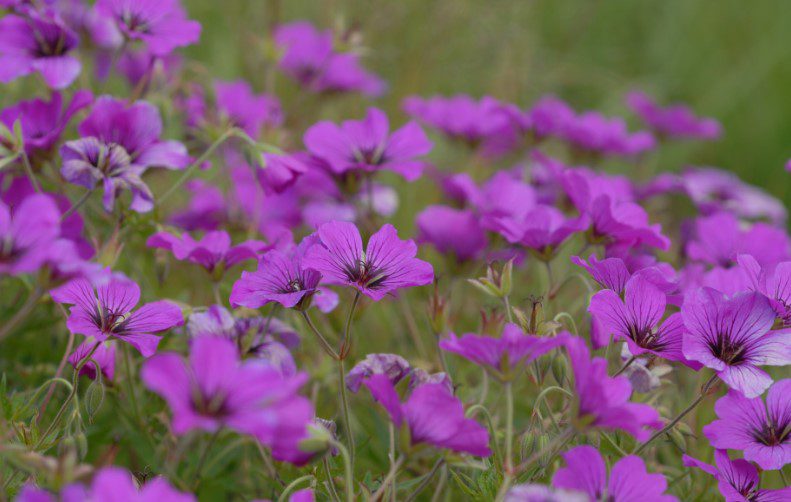Cranesbills Geraniums

Ask me to name the most dependable, resilient, and versatile plants in the garden, and my answer would be cranesbill geraniums.
Some years are good for roses and others for delphiniums, but every growing season is successful for Geranium.
These hardy perennials, whose common name comes from their extended, pointy seed capsules, are related to the South African annual Geranium, properly called Pelargonium, often found stuffed into pots on sunny decks and patios.
But the perennial Geranium is a native of temperate regions and a northern gardener’s problem-solver and joy–generous with its bloom, free from pests, and easily maintained.
Most of which are hardy to Zone 4, these relaxed and charming flowers are the backbone of many happy gardens.
Some even have leaves that turn red in autumn.
Cranesbills Medical Uses
Known by country folk as old maid’s nightcap or shameface, geraniums have long been used for medicinal purposes and were well represented in the pages of Old World herbals.
For example, Nicholas Culpeper said they’re astringent, good for healing wounds and curing ulcers.
Cranesbills Varieties
A wild geranium herb Robert (see “Herb Robert,” was used in Elizabethan times to edge garden beds, and some modern hybrids are also helpful and attractive for that purpose.
The dwarf alpine hybrids of G. cinereum (10 to 15 centimeters tall)–pale lilac-pink ‘Ballerina,’ reddish plum ‘Purple Pillow‘ and magenta ‘Splendens’–are all suited to edge planting.
For slightly taller plants, I like two cantabrigiense hybrids (both 15 to 20 centimeters tall): milk white with a pink-flushed throat ‘Biokovo‘ (a self-hybridizing Balkan cultivar, from G. dalmaticum and G. macrorrhizum); and pinkish mauve ‘Cambridge,’ named for its English breeding site.
The first Geranium to find a place in my garden was an impulse buy spied in another customer’s basket in the nursery checkout line.
The black-eyed, sizzling, magenta-purple flowers of G. psilostemon (90 to 120 centimeters tall) vibrate with intensity, and its leaves turn a brilliant flame red in autumn.
This lanky plant needs a bit of discreet support, but its hybrid descendant ‘Patricia’ (60 to 75 centimeters tall), with black-eyed, magenta-pink flowers, stands up all by herself. ‘
Ann Folkard’ adds chartreuse-yellow leaves and a clambering habit to the black-eyed, magenta-purple color combinations and can weave herself through the lower regions of rose canes.
Long-lasting color is always a bonus with cranesbill geraniums, and they usually remain in bloom for four to six weeks.
My longest-blooming plants are the magenta-purple-flowered bloody cranesbill (G. sanguineum) and its white-flowered sister, ‘Album’ (both 45 to 60 centimeters tall).
They have passed along their staying power to their more compact offspring, such as carmine-rose ‘Max Frei’ (15 to 20 centimeters tall), reddish-purple ‘New Hampshire Purple’ (20 to 30 centimeters tall), and G. s. var. striatum ‘Lancastriense’ (15 to 20 centimeters tall), which boasts pale, blush pink blooms with dark crimson veins.
All open their first flowers in mid-May; if their soil is kept moist, they’ll keep flowering into August or even later.
I wouldn’t be without that old standby dusky cranesbill (G. phaeum, 60 to 75 centimeters tall) in my garden, also known as mourning widow (each leaf is marked with a small black spot to denote the poor woman’s grief).
IT tolerates the dry shade canopy of woodland trees, putting out dark, nodding, maroon-purple flowers in May and June.
My favorite cultivar of this species is ‘Lily Lovell’, which has a brighter and larger mauve-purple flower with a white eye, but she is hard to find.
A has taken her placeA new G. phaeum introduction has taken her place, ‘Samobor’ (60 centimeters tall), its leaves heavily marked with a rich, chocolate-maroon color.
‘Espresso’ spotted cranesbill (G. maculatum ‘Espresso,’ 30 to 40 centimeters tall) has even more dramatic, dark coffee brown foliage and soft pink flowers, while two of the meadow cranesbills,
G. pratense ‘Midnight Reiter’ (20 to 25 centimeters tall) and ‘Victor Reiter Jr.’ (45 to 60 centimeters tall) have plum purple leaves violet-blue flowers and grow well in part shade to sun.
When searching for flowers that are adaptable, compact, and long-blooming, consider hardy geranium plants (Geranium spp.).
Also called cranesbill geranium flower, the plant comes in colors ranging from pinks, blues, and vivid purples to subdued whites.
Attractive, cup shaped or frilly flowers bloom profusely and spread abundantly. The tough geranium flower blooms in late spring and lasts until fall.
Some hardy geranium plants have attractive foliage that lasts until nipped by frost.
How to Plant Hardy Geraniums
Growing hardy cranesbills geranium may be as easy as planting and watching it blossom when conditions are somewhat damp.
Hardy geranium plants grow best in consistently moist soil when first planted, but become somewhat drought tolerant when established.
Cultivating hardy cranesbill geranium in fertile soil also encourages the plant to spread. Many varieties of hardy geranium plants exist and thrive in full sun to shady locations.
When considering the way to plant hardy geraniums, think of the location where you wish to plant and choose an appropriate plant for the available sunlight.
Locate the plant where it has room to sprawl, clipping the edges back if necessary to keep it within its boundaries.
Some varieties may be used as ground cover, while others are attractive as border plants.
Brighten the rock garden with various cultivars of the cranesbill geranium flower, which may be as short as six inches (15 cm.) or as tall as three feet (1 m.).
Smaller varieties may cascade from containers. Hardy geraniums should be planted in the way that crown of the plant is at soil stage; planting the crown more deeply may result in the loss of the cranesbill geranium flower.
Hardy Geranium Care
Hardy geranium care includes the removal of spent blooms and occasional watering for the best performance.
When mature, the cranesbill geranium flower has few insect pests and takes only limited fertilization.
Rich organic soil is usually all the plant needs for optimum growth and flower set.






















